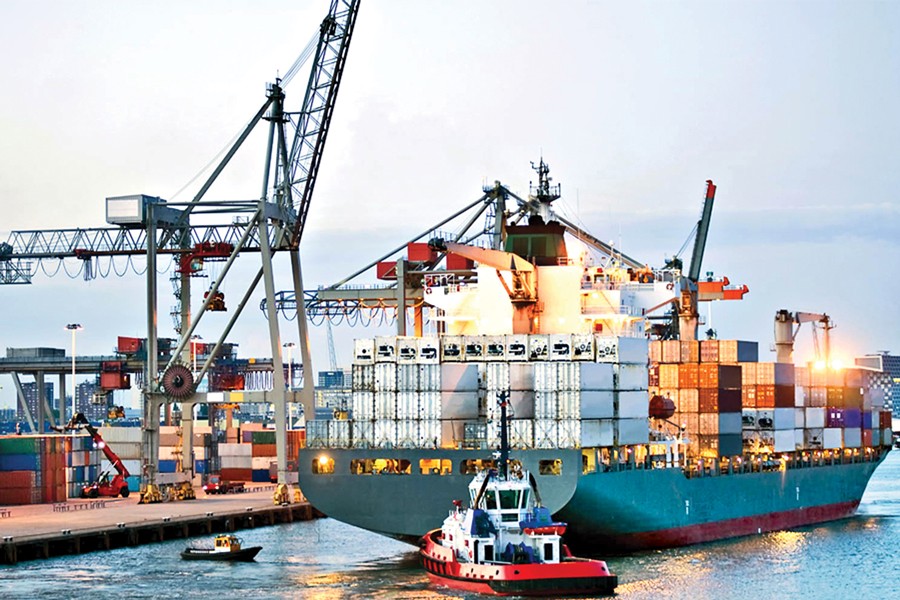Hossain Mohammed Omar Khayum and Md. Lutfay Tariq Rahman | November 23, 2017 00:00:00
 A container vessel at a port: The shipbuilding industry in Bangladesh has great potential
A container vessel at a port: The shipbuilding industry in Bangladesh has great potential  After an impressive success in reaching the targets of Millennium Development Goals (MDGs), presently Bangladesh is taxiing on the runway to take off towards a higher scale of development. For success in reducing poverty, reducing the prevalence of underweight children, ensuring access to improved sanitation in both urban and rural area, lowering infant mortality and maternal mortality rates and increasing primary-school enrolment, Bangladesh has been praised internationally. According to the European Commission, with declining aid-to-GDP ratio and relatively low public spending compared to other developing countries in its account, the country is now maturely looking forward towards the Sustainable Development Goals (SDGs) which are focused on a healthy development with 17 specific goals accumulating most aspects of economy, society and environment.
After an impressive success in reaching the targets of Millennium Development Goals (MDGs), presently Bangladesh is taxiing on the runway to take off towards a higher scale of development. For success in reducing poverty, reducing the prevalence of underweight children, ensuring access to improved sanitation in both urban and rural area, lowering infant mortality and maternal mortality rates and increasing primary-school enrolment, Bangladesh has been praised internationally. According to the European Commission, with declining aid-to-GDP ratio and relatively low public spending compared to other developing countries in its account, the country is now maturely looking forward towards the Sustainable Development Goals (SDGs) which are focused on a healthy development with 17 specific goals accumulating most aspects of economy, society and environment.
Since its inception, the country has faced three trade regimes. The first one, starting from 1971 to 1980, was a 'restricted' one. Then the days of 'moderate trade' were from 1980 to 1991. And lastly, from 1991 to present days we are experiencing 'rapid trade liberalization'. After 1971, in a war-torn country open economy was not feasible. For this reason, to gain self-sufficiency, restrictions on trade were imposed. Private entrepreneurs didn't exist then. The government found 'import substitution' suitable for the economy. The target was to keep the import basket lighter as the export basket couldn't offer much. The then economy was 'inward-looking economy'. The state used to decide how much of what should be imported and produced.
As private-sector expansion was restricted and limited, with the emergence of nationalized banks, insurances, industries etc. the public sector expanded. The dominating role of the then government was suggested and as well as supported by the contemporary economists. After 1980, the government decided to be a bit liberal and tried to adopt 'moderate trade policy'. The state started supporting privatisation and the country started moving from an 'inward-looking economy' to an 'outward-looking economy'. With significant success in privatization the volume of both import and export increased and the potentials of private sector were realised. In the third stage, the 'private-sector development' found a strong base when the trade-liberalisation process got a boost and the economy became significantly more open.
In the last fiscal year (2016-17) Bangladesh's export earning was $34,846.84 million whereas the import expenditure was $47,005.20 million. So, there was a trade deficit of $12,158.36 million. Bangladesh's main export sector is the Readymade Garments (RMG) which accounts for 82 per cent of total exports. Major non-apparel export items are leather and leather products, jute and jute products, tea, frozen fish, furniture, ceramics, shrimp, vegetables, bicycles etc. Exports of non-apparel items rose by 7.49 percent to $1.51 billion in the first quarter of this fiscal year. Actually, it is essential to increase the contribution of the non-apparel sector in the national export earnings and it has been targeted as 25 per cent according to the seventh five-year plan. Moreover, it is not wise to be more dependent on a particular sector.
The country's leather industry is very much promising. According to experts, Bangladeshi leather comes just after the European and the Pakistani ones in terms of quality. At present Bangladesh gets $1.17 billion of export earnings from this sector. But according to experts, with proper facilities it can be increased to $5 billion.
Shipbuilding industry is another one in which Bangladesh has great potential. Already several Bangladeshi shipbuilding companies have secured some excellent contracts from Europe and have exported ships to Denmark and Kenya. The potentials of shipbuilding in Bangladesh have made the country comparable with China, Japan and South Korea.
Also, it is quite interesting that the demand for Bangladeshi toys is gradually increasing in the European market. In the 2016-2017 fiscal year, export earnings from this sector rose to $15.8 million which is double that of the last fiscal year.
The government needs to focus on these sectors and provide support to the industries.
A survey conducted by SANEM (South Asian Network for Economic Modelling) found that inadequate facilities at Benapole and Petrapole land ports hamper bilateral trade between Bangladesh and India. Instead of the eight-hour working day, these ports are effective for only four hours a day. Also, situation is not satisfactory in other aspects like infrastructure, regulatory and administrative procedure, facilities, use of digital and advanced technology, storage capacity, basic utilities including water and electricity etc. This scenario is not at all acceptable because these two land ports handle about 80 per cent of trade between the two countries. The unloading process is also time-consuming, as a truck has to wait about 17 to 20 days to unload products at Benapole.
The situation is far worse in case of seaports considering that only Chittagong seaport is responsible for accommodating more than 92% of the country's total trade activities. Buffering in the unloading process of ships and container congestion are the major problems the Chittagong port is currently facing. To reach the pier from outer anchorage a ship has to wait up to 12 days where the normal case scenario is just one day. For this reason, the international shipping corporations have increased the fare for the shipments heading towards Chittagong (Bangladesh). For example, some Chinese corporations have increased the fare from $50 to $275 based on different container types.
Due to this, the importers and the entrepreneurs are facing immense economic losses. According to estimation, the traders will have to pay an extra amount of Tk 800 million which will eventually be added up with the retail prices of the respective products. Again, the imported products are mostly the raw materials for RMG and Knitwear. For the whole unloading process, it takes up to 15-20 days and it is directly hampering the RMG sector. Because, the nearest competitors like China, India, Vietnam, Cambodia etc. are more efficient due to their strong port infrastructures.
In addition, the exports of Bangladesh have not been increasing for some more reasons, like lack of diversity in Bangladeshi goods, non-tariff barriers, weak or no lobbying efforts by the government, lack of market diversification and so on. In the early 1990s, Vietnam used to stand behind Bangladesh in terms of export earning but at present its export earning is $169.2 billion which is nearly 5 times that of Bangladesh.
Theoretically, in a capitalist economy, a completely liberalized global market is the most efficient way to foster growth, because each country focuses on producing the goods and services in which it has a comparative advantage. Yet, in reality, removing trade barriers and opening markets do not always necessarily generate development; effective policies play a vital role here. Again, free trade is not equally free. There are barriers which include tariffs and non-tariff barriers (import licence, export licence, import quota, subsidy, voluntary export restraint, embargo, currency devaluation, trade restriction etc.). After all, Bangladesh is a developing country. Enhancing and reconstructing regional co-operation could be a useful tool to promote trade. Though building trust, managing the distribution of wealth and protection of the vulnerable are responsibilities of government, the businesses need to play greater roles as the contemporary world is advancing towards automation to revolutionize the way people survive and perform.
Omar and Tariq both are postgraduate students at the Department of Development Studies, University of Dhaka. In addition, Omar works as a Research Associate at the Department of Development Studies, University of Dhaka. Omar can be reached at [email protected] and Tariq at [email protected].
© 2024 - All Rights with The Financial Express
